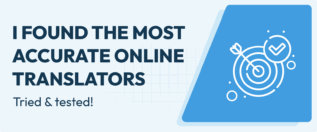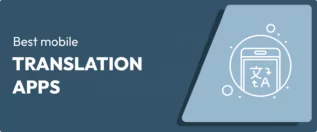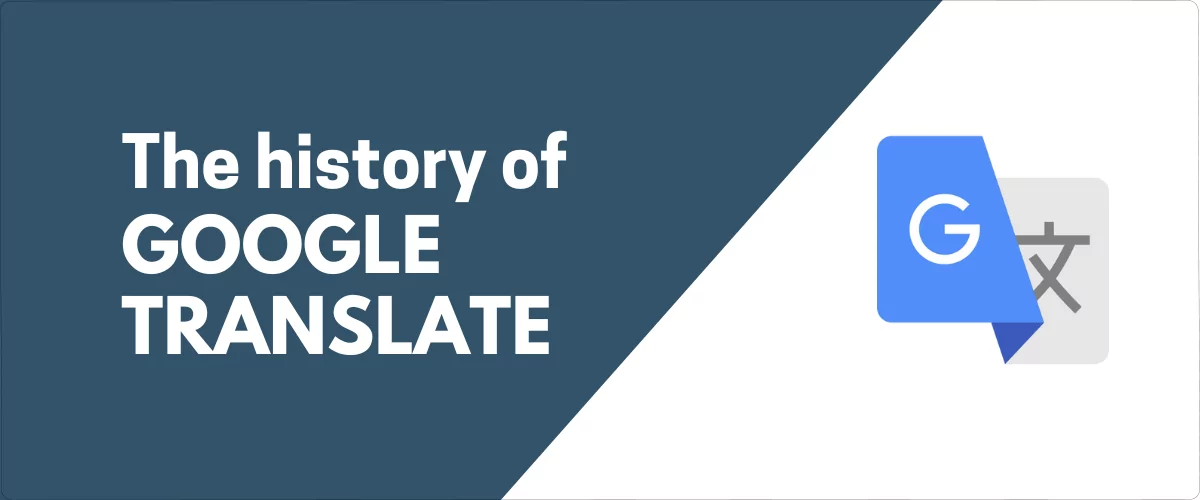
In this post
Machine translation tools have revolutionized global communication. They make it possible for people around the world to talk, connect, and do business with each other. And in this post, we want to look at the history of one solution that has consistently been at the forefront of this change: Google Translate.
For many, Google Translate is the online translation tool. It’s free, powerful, and millions of people around the world use it regularly for different purposes, including website translation. The service has introduced many innovations over the years that made automatic translation more accessible than ever. By now, it’s a valid alternative to human translation.
However, that wasn’t always the case and it has been a long road to get to this point. To give you a better idea about the developments on the way and the obstacles the engineers had to tackle, below we’ll shine a light on the history of Google Translate up to this point.
The Origin of Google Translate (2004-2016)
Though Google Translate officially launched in 2006, its history actually goes back further – to 2004. Google co-founder Sergey Brin, who was born in Russia, was frustrated with the machine translation tools of the time.
As a consequence, he helped create Google Translate which went live in early 2004 with only two languages, English and Russian. This version of Google Translate was based on SYSTRAN, a form of machine translation. It was very inaccurate even at the time.
Gradually, Google Translate received more languages, but the going was slow. Still, it was able to translate entire web pages, if only to the limited target languages.
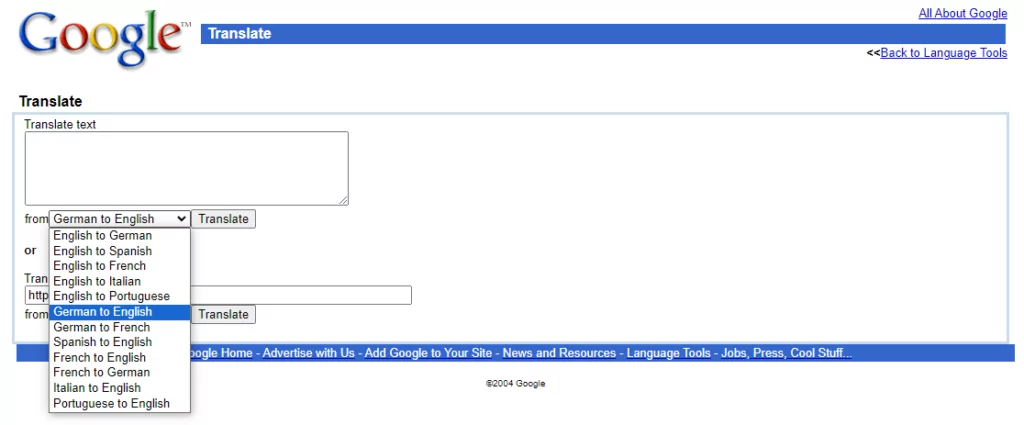
The service launched into proper beta on April 28, 2006. One innovation it came with was statistical machine translation. It had been developed after months of work and study by the linguists involved. While the new system was only available for Arabic and English, it was a great step forward. Other languages soon started taking advantage of the new modern machine translation format.
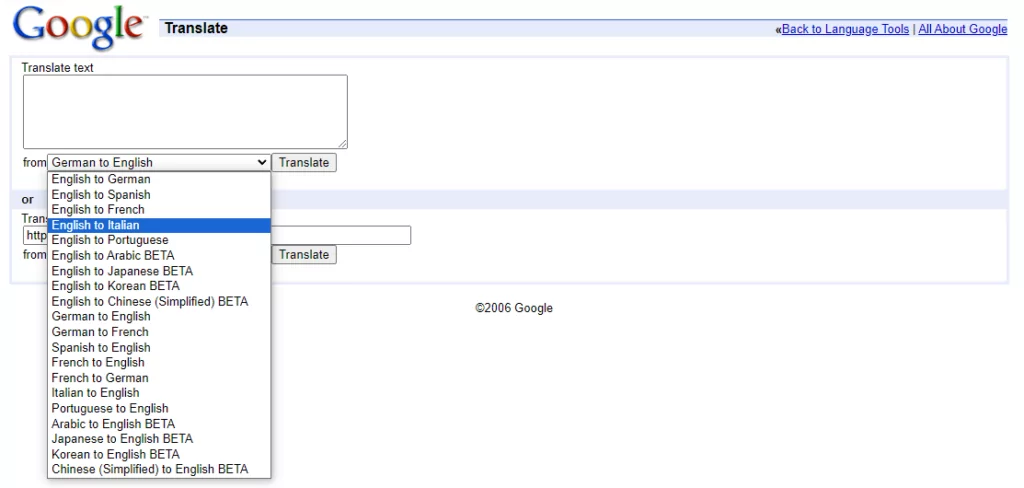
Struggling With Inaccuracy
Still, while this version of Google Translate was a massive improvement and groundbreaking at the time, it was fairly inaccurate by modern standards and often resulted in confusing gibberish. One of the main reasons for that was the fact that every input was first translated into English and only then into its target language. This two-step translation often introduced errors and awkward phrasing (such as these bad Chinese translations).

This version of Google Translate also used phrase-based machine translation, or PBMT. This technique breaks down sentences into smaller chunks or phrases and translates them individually, rather than word-by-word. PBMT uses patterns to predict the most likely translations. It greatly improved the accuracy of machine translation at the time. Yet, despite the model being trained on millions of United Nations and European Parliament documents, it still struggled with context.
Google Translate continued to rely on statistical machine translation until 2016, steadily adding more languages and improving translations. Over ten years, the development team and linguists worked continuously on refining the algorithms and translation accuracy. They also added several useful features to the tool.
As a result, Google Translate turned into a fairly reliable, accessible translation tool, which was sorely needed. As the Internet became a staple in people’s lives and talking and selling to others halfway across the globe the norm, human translators could no longer keep up.
Early Google Translate Milestones
Before its big overhaul in 2016, Google Translate saw several key milestones that marked its development and expansion.
One of the first additional features to be released was support for the translation of individual web pages. Around 2008, Google Translate gained the ability to embed it into a website and translate content to any language. Since 2010, Google Chrome has been able to do this automatically.
2010 was also the year Google introduced an Android app for Google Translate, and an iOS app a year later. This made communication in different languages even more feasible; you no longer needed a desktop computer for it.
Around this time, Google Translate also gained new features like text-to-speech to show how to pronounce your translation. Its app could even identify and translate words in pictures.

Then, in 2014, Google acquired Word Lens, an AR translation application, and quickly integrated its features into Google Translate and its app. Word Lens was even better at identifying text through images. It also supported speech translation through voice input, making active conversations even more fluid.
Transition to Neural Machine Translation (2016-2020)
By early 2016, Google already supported 100+ languages. It also introduced a Phrasebook where you could save translated phrases for later, instant translation, the ability to correct its output, and learn more context about the words and phrases you translate.
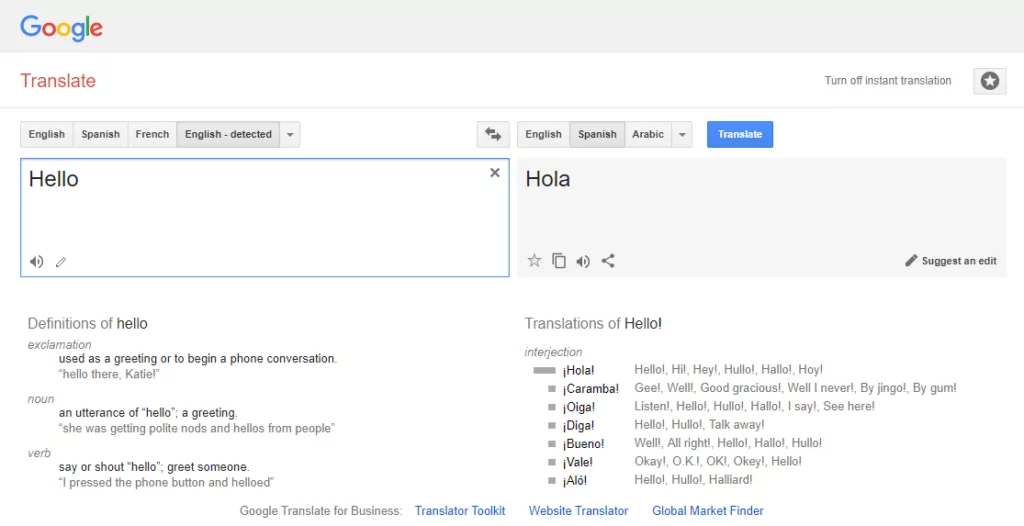
But the next biggest change was already at hand. While celebrating Google Translate’s tenth anniversary, its parent company was making big plans for a transformative shift. In November of that year, they introduced Google Neural Machine Translation.
Departing from the traditional phrase-based machine translation and statistical machine translation methods they’d used before, this new method was far superior. It had been in the making since 2011.
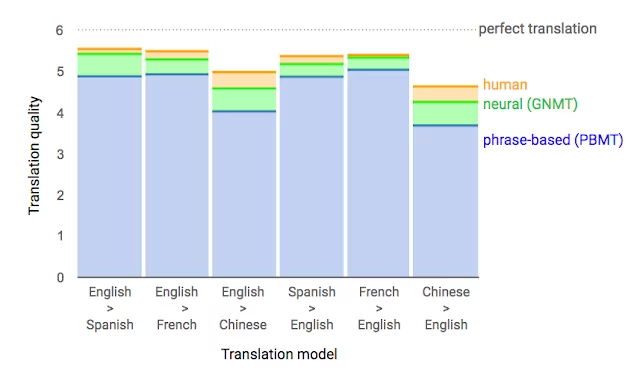
Neural Machine Translation employs deep learning techniques, specifically neural networks. It processes and translates entire sentences as opposed to breaking them down into smaller phrases like PBMT. This approach is far more context-aware and thus more accurate and fluent.
NMT systems are trained on vast datasets of multilingual text, learning to recognize patterns and relationships between words and phrases. And as this system is exposed to more data, it learns and becomes even more proficient.
Plus, GMNT allowed the tool to translate directly into the target language, rather than first translating into English.
At first, this new approach was only available for English, French, German, Spanish, Portuguese, Chinese, Japanese, Korean, and Turkish. Over time, more and more languages got to benefit from it and translation quality shot up.
It was a big leap forward in the history of Google Translate. But unlike statistical machine translation, which lasted over ten years, Google was quick to innovate further.
Google Translate Today: Deep Learning and Transformers (2020-Present)
By 2020, Google was already putting together its next big leap in machine translation. GMNT began to be phased out, and replaced with a more modern neural network model based on transformers.
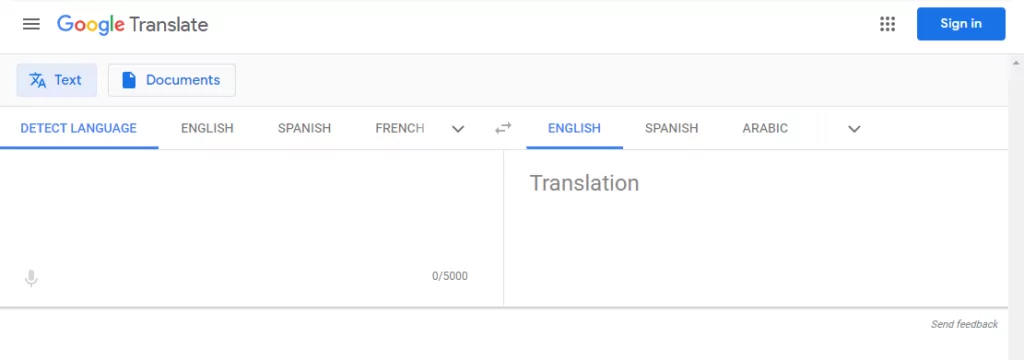
While GMNT worked very well for particular languages that had a lot of data and documents available for training, it struggled with less-used languages. Google made it their mission to take advantage of the recent advances in machine learning and train an even better model.
Transformers represent a substantial improvement over previous neural network architectures. They use a mechanism called self-attention. It allows the model to weigh the importance of different words in a sentence relative to each other. This enhances context sensitivity and the ability to make accurate predictions even further.
Transformers can analyze an entire sentence or even document in a way that captures the nuance and context of the text more effectively. As a consequence, their translations are far more natural and closer to human-level fluency.
And according to Google’s research on their transformer-based translation system, these models have resulted in substantial gains in translation quality. That’s particularly for languages with less available training data.
And that’s where we are now. Year by year, Google trains its model on more data, improving the quality of translations, and bringing in additional languages.
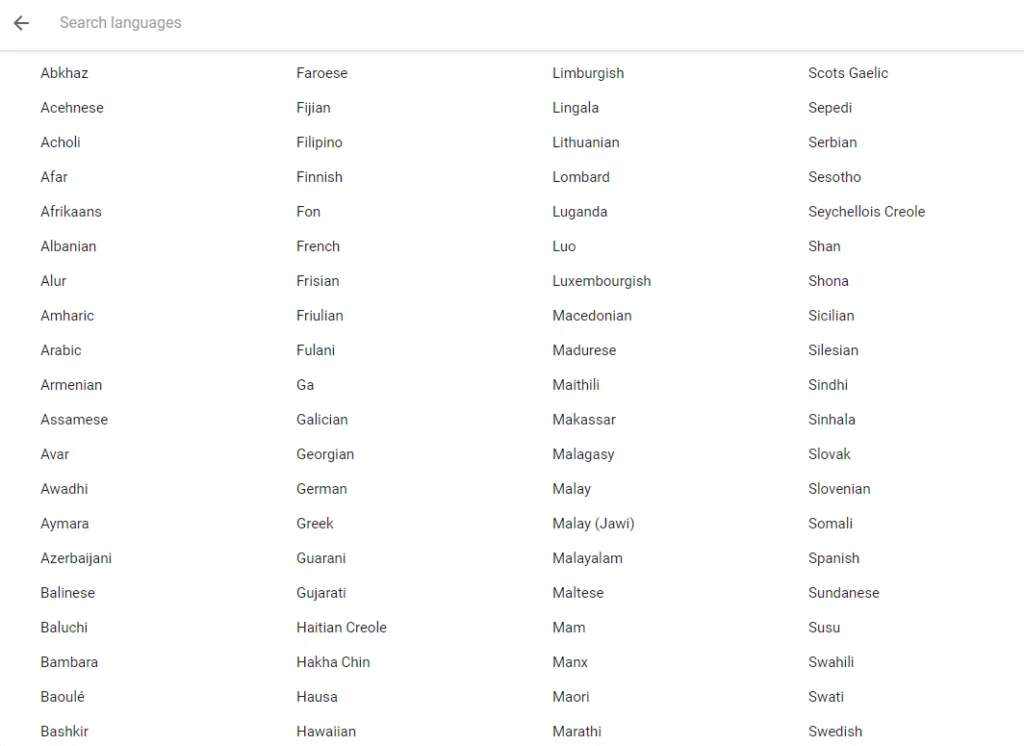
In fact, Google just announced that they’re including 110 new languages in Google Translate. That’s the most they’ve ever added all at once. Thanks to the power of AI, these new machine learning models can handle even rarely-spoken languages with almost zero online presence far better than ever before.
The Impact of Google Translate, Machine Learning, and AI on Translation
Google Translate is now the best it’s ever been. Advances in machine learning and artificial intelligence in the past five years have revolutionized translation in several ways.
- Increased accuracy – AI-powered models, especially those using deep learning and neural networks, have significantly reduced errors that machine translations were once prone to. By analyzing entire sentences and larger contexts, these models produce more fluent translations.
- Context awareness – Advanced AI models can better understand the context of words and phrases. This leads to translations that capture the intended meaning rather than just a literal word-for-word language conversion. Machine translations feel more natural as a consequence.
- Real-time translation – Machine learning has enabled real-time translation capabilities. You can now actively hold a conversation in different languages, making traveling the world much more accessible.
- Voice and image translation – Artificial intelligence has also facilitated the development of voice and image translation. Users can speak into an app or point their camera at text to instantly learn its meaning. We’re far past the days of having to type in everything manually.
- Continuous improvement – AI models are designed to learn and improve over time. With each interaction and additional data input, these systems become better at recognizing patterns and nuances. And as more data sets become available and integrated, so does their knowledge deepen further.
Google Translate has not only improved in terms of precision but, thanks to AI, has also introduced a range of new features that make translation more accessible. They include the ability to download languages to your phone so you can use the service even without an Internet connection.
It remains to be seen where AI will take us. In the future, machine translations may be indistinguishable from human output. One thing is certain, though: through its history of constant improvement, Google Translate has played an integral part in laying a solid foundation for AI-powered machine translation.
Make History by Using Google Translate on Your WordPress Website
If you want to bring the power of Google Translate to your WordPress website, you can do so easily with TranslatePress. Our plugin allows you to integrate your website with their neural machine translation in two different ways. Both of them are super easy to set up.
TranslatePress Multilingual
Take Advantage of TranslatePress AI
The first step to add Google Translate to your site is to use the TranslatePress AI. It automatically converts your entire website to another language instantly and uses a combination of the world’s leading neural machine translation engines, including Google Translate. In addition, all input is fed through TranslatePress’ own AI systems for refinement.
Plus, the setup is minimal. Be aware, however, that TranslatePress AI is a premium feature.
After installing TranslatePress on your website and activating your license, simply go to Settings → TranslatePress. Here, select both your website’s default language and the target language(s) you want to offer it in.
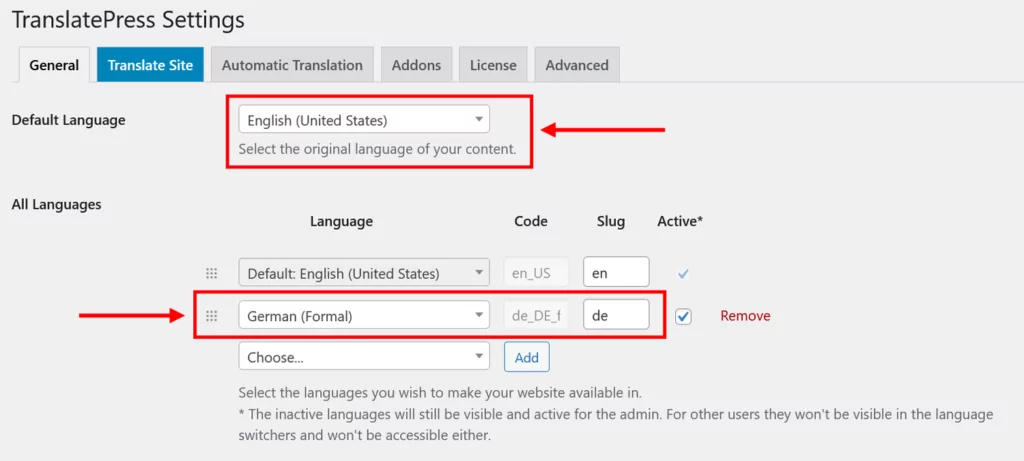
While you are at it, you might also use the options to style your language switcher further below. Once happy, click Save Changes at the bottom of the page.
Then, your next step is the Automatic Translation tab. Here, your first task is to switch the drop-down menu for Enable Automatic Translation to Yes.

This opens up a range of new options.
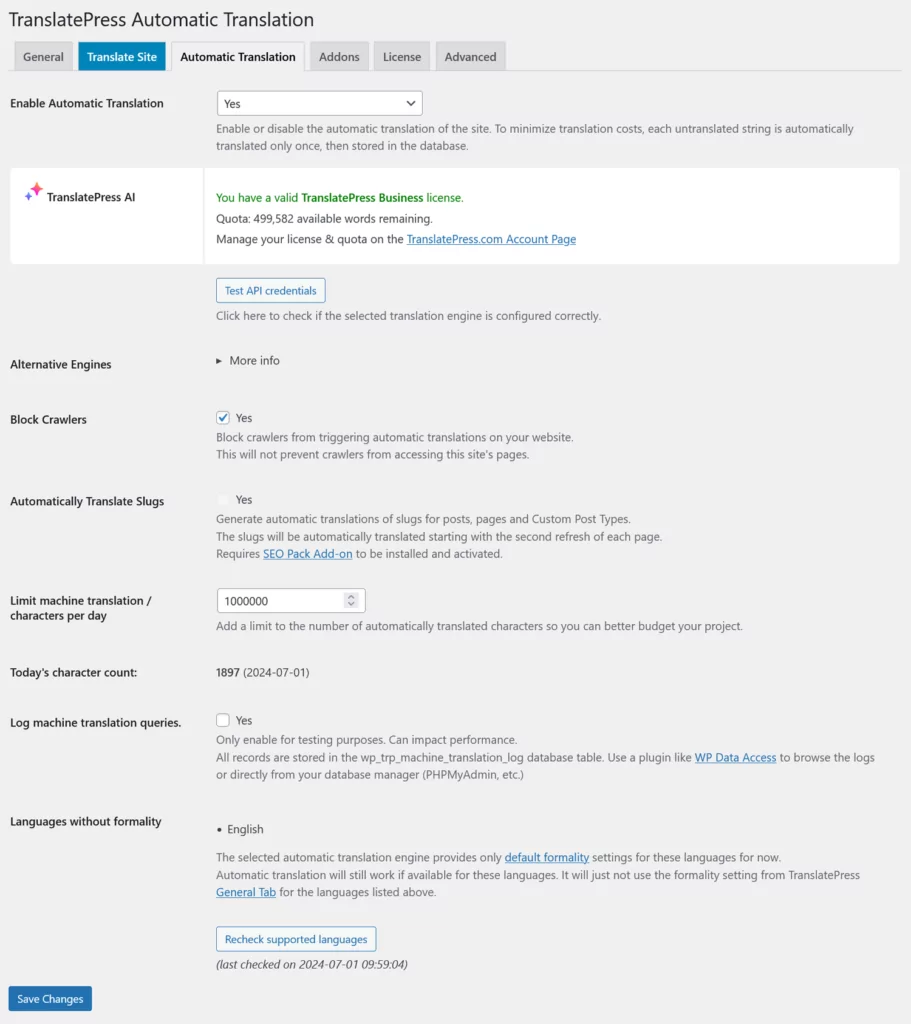
TranslatePress AI is the default setting for machine translation. The page will also show you the number of words that still remain as your credit.
You don’t really have to do anything else here except maybe check out the other configuration options, most importantly the menu to limit the translated characters per day.
Once done, save at the bottom again. That’s pretty much it. TranslatePress will now automatically start translating your website. When you go to the front end and use the language switcher to change to your target language, you can see that the translations are already present.
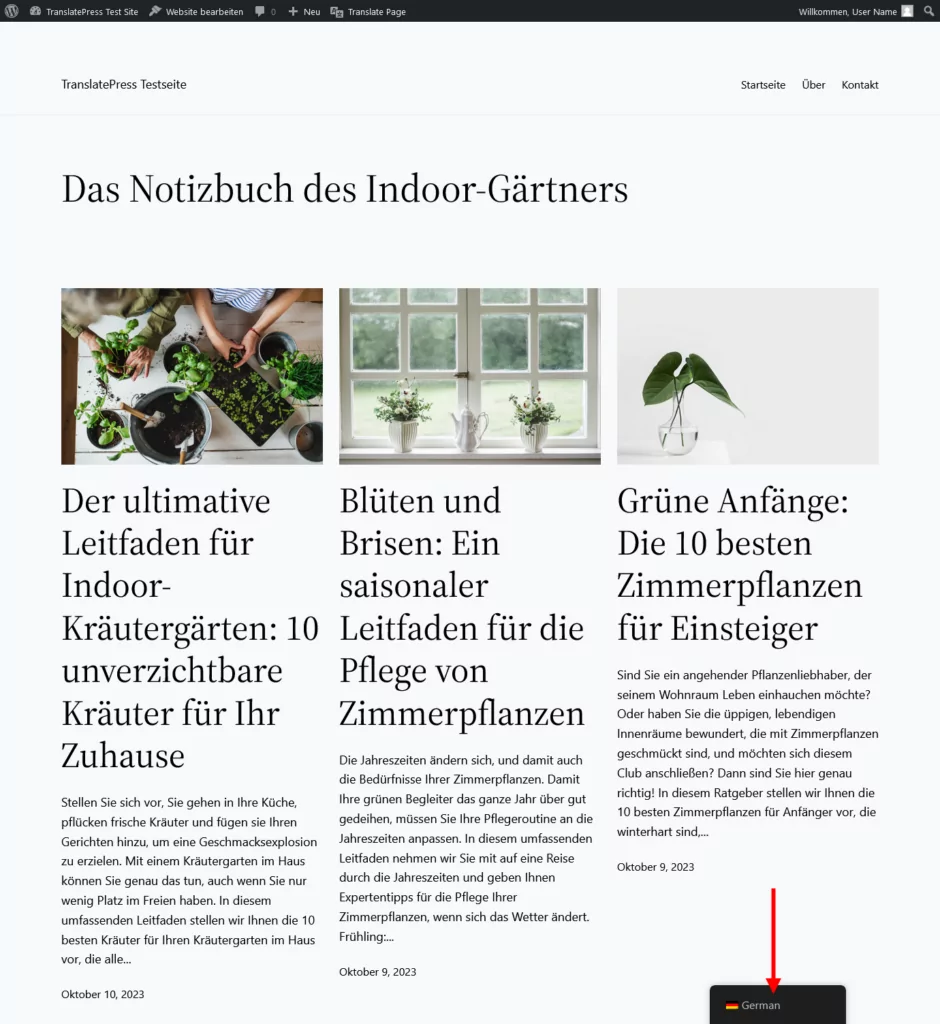
Refine as Necessary
If you feel like the AI didn’t fully grasp the meaning of one of your strings, no problem. You can always refine your website translation manually.
For that, click on Translate Site in the TranslatePress settings or the WordPress taskbar (it also shows up on the front end of your site).

This takes you to the translation interface. It has a preview of your site on the right and translation tools on the left.
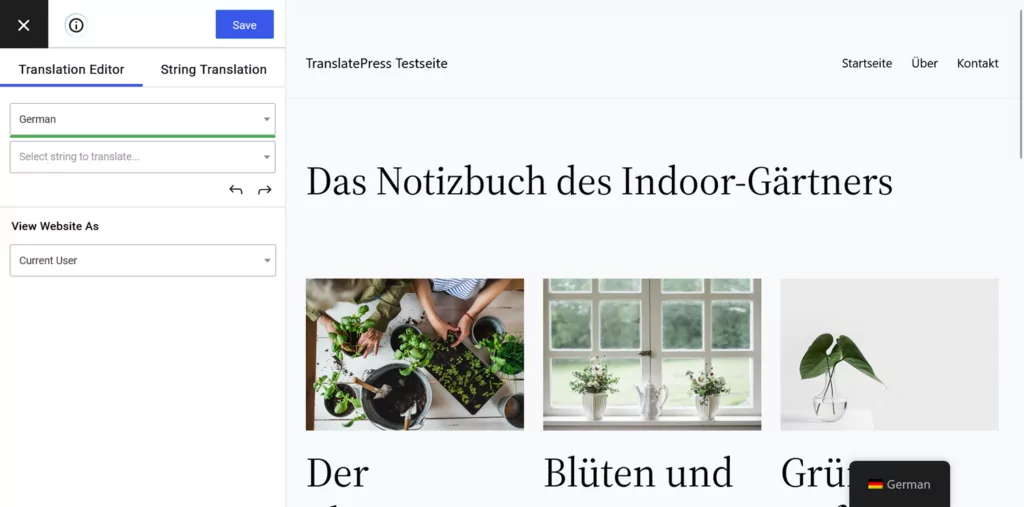
Use the preview window to navigate to the part of your website where you want to make an edit. Then, choose your desired content through the drop-down menu, forward and backward arrows, or by clicking on any string in the preview screen. Doing so will display both the original string and its translation in the left sidebar.
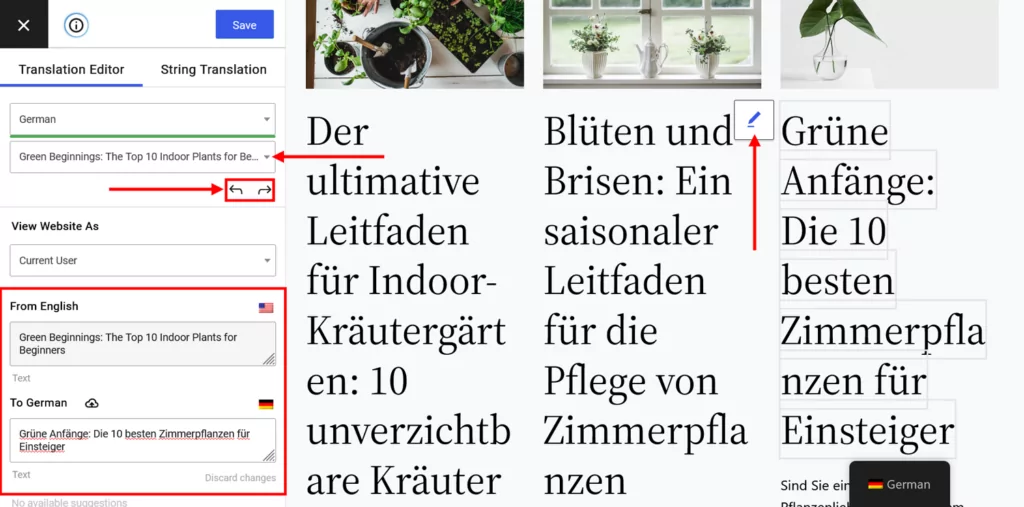
Simply edit the translated part, then save at the top (or use Cmd/Ctrl+S on your keyboard).
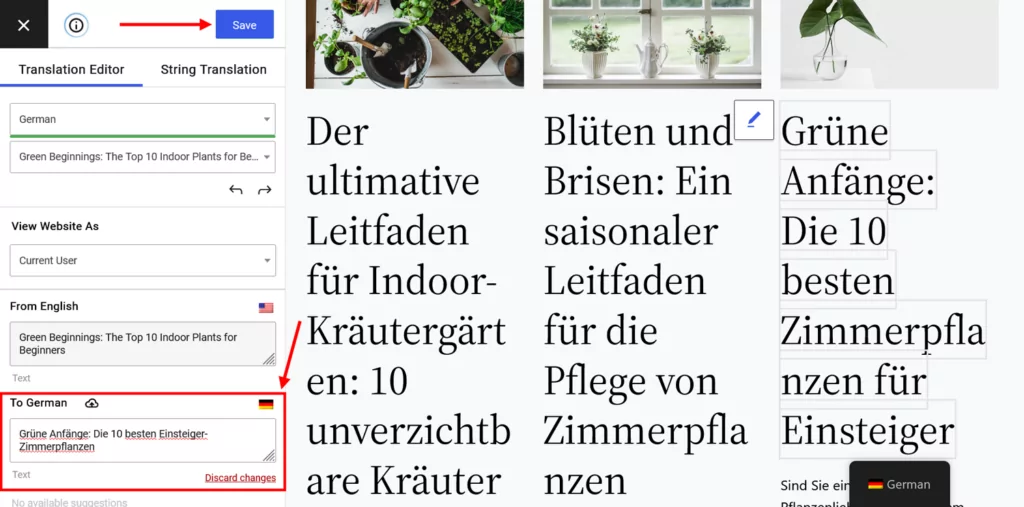
That’s it. From now on, the corrected version will appear on your site.
Use the Google Translate API Directly
If you don’t have a TranslatePress license or you specifically want to use Google Translate for converting your site, you can also do that. All you have to do is go back to Settings → TranslatePress → Automatic Translations. Then, under Alternative Engines, choose Google Translate (if you have a license, DeepL is also available).

The next step is to obtain an API key, for which we have a detailed guide. Alternatively, use the link underneath the input field to find these instructions.

After providing the API key and saving, go back to the translation interface of TranslatePress. With Google Translate activated, whenever you choose a string in the preview window, the translation should immediately appear in the input field for the target language.
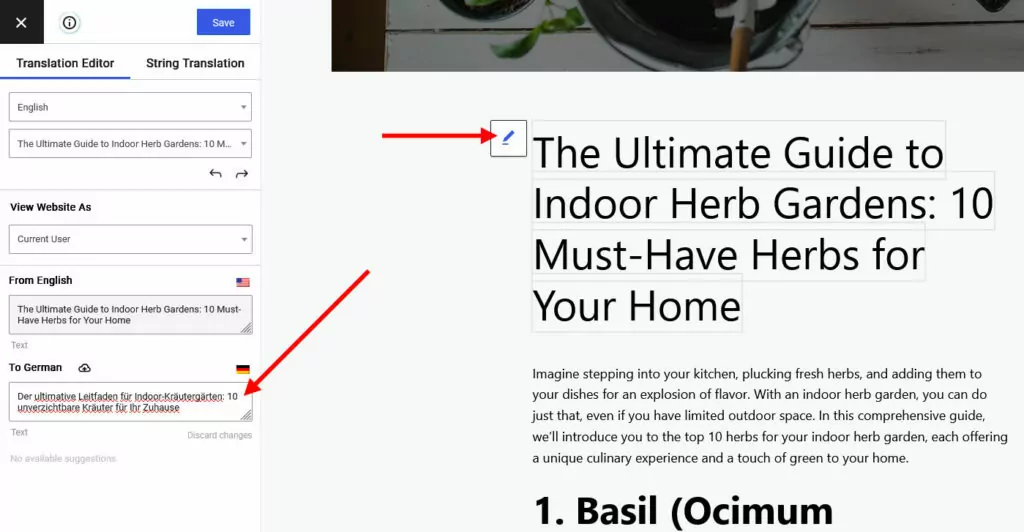
Check it for correctness and make any changes you want, then save. Done.
Other Useful Features of TranslatePress
Besides unleashing the power of Google Translate on your website, TranslatePress additionally offers the possibility to translate your images. It happens in the same interface and pretty much works the same way as for text.
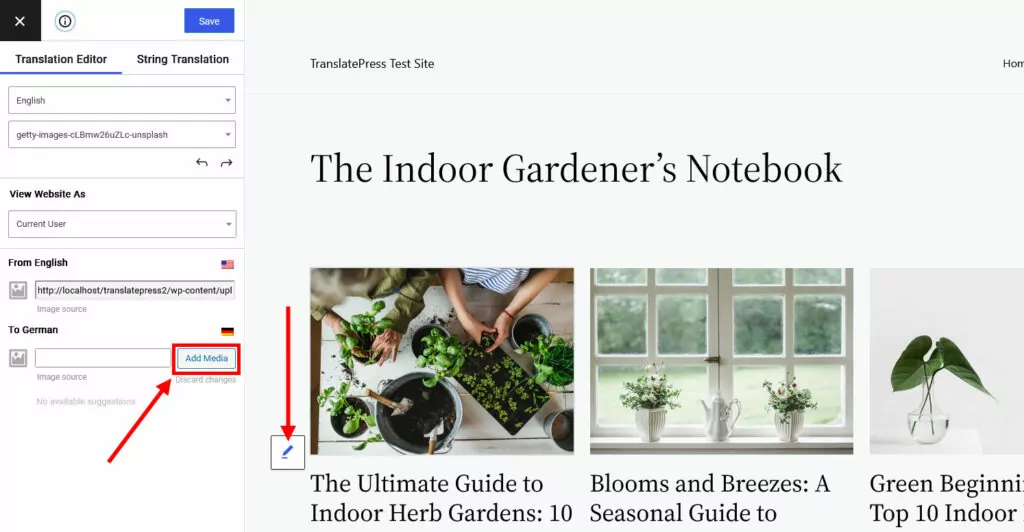
Besides that, with the premium version of TranslatePress, you gain access to these features:
- Multilingual SEO — Translate page links, SEO titles, meta descriptions, ALT tags, and other important SEO elements with our multilingual SEO pack. It also automatically creates sitemaps for your different languages and works with most of the popular WordPress SEO plugins.
- Translator Accounts — If you decide to outsource the translation of your website to freelancers and agencies, the TranslatePress Business and Developer licenses allow you to create dedicated accounts for them so they can work directly on your website.
- Language-specific navigation – Automatically show different menus depending on the language chosen by the user.
- Automatic language detection – Offer your site in your user’s preferred language without them having to switch to it manually.
TranslatePress comes with three different pricing tiers. The free version lets you add one additional language to your WordPress site. The pricing table below has more information.
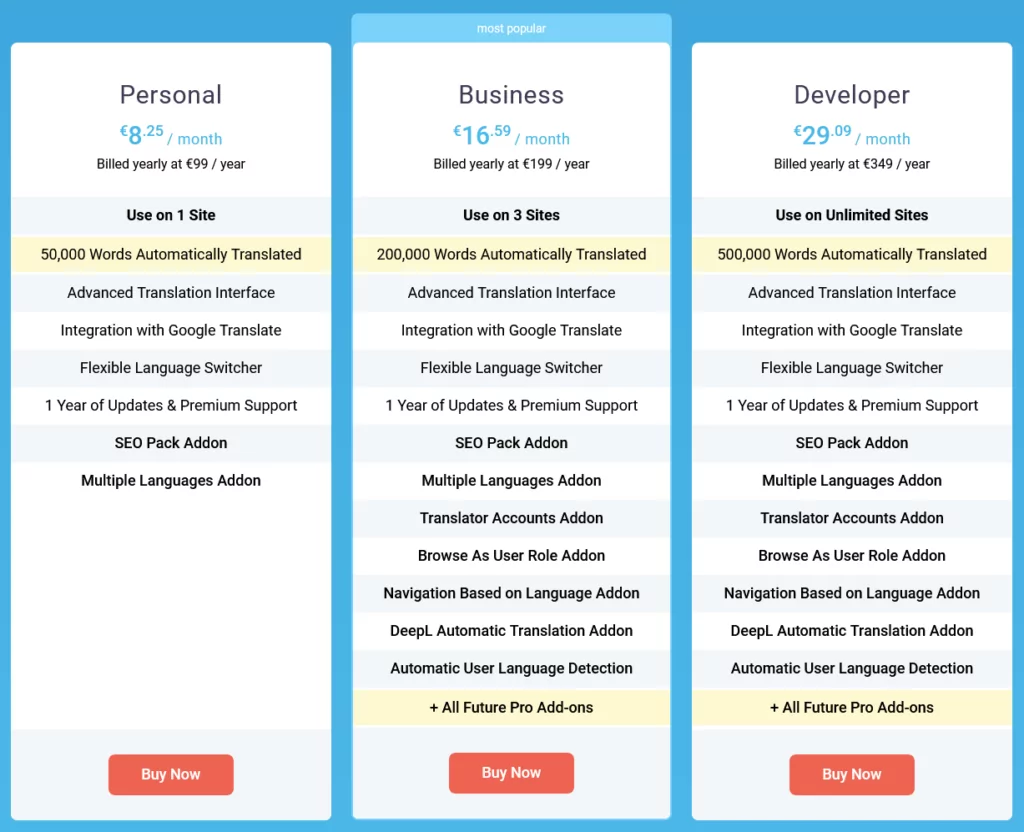
From the History of Google Translate to the Future of Translation
Google Translate has gone through many changes over the years. Evolving with the technology available, it is now more accurate than ever.
As one of the precursors of machine translation, the service has impacted the lives and businesses of hundreds of millions of people, with no end in sight. As Google’s transformer models take in more and more info, its translations will become even more accurate and apply to even more languages.
By integrating TranslatePress AI into your projects, you can harness the power of Google Translate and other AI-powered translation services on your own website. Effortlessly translate your site and make it more accessible to a global audience. As you have seen above, it only takes a few clicks.

